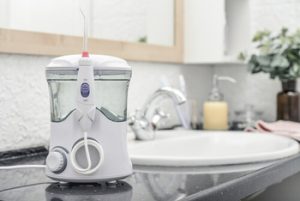Oral hygiene is a cornerstone of overall health, yet those with braces often encounter unique challenges in maintaining it. Braces, while instrumental in achieving that picture-perfect smile, can also be a haven for food particles and bacteria. Traditional flossing methods, though effective, sometimes fall short in navigating the intricate nooks and crannies around brackets and wires. Enter the water flosser: a modern solution to this issue.
Water flossers harness the power of water pressure to effectively clean between teeth and around braces, making them an invaluable tool for brace wearers. This article delves into the advantages of using water flossers for those with braces, offering insights into their functionality, efficiency, and how they can elevate one’s dental care routine. Dive in to discover why a water flosser might be the upgrade your oral hygiene regimen needs.
What is a Water Flosser?
Harnessing the strength of water pressure and technological innovation, the water flosser has emerged as a modern solution to age-old dental challenges. This section delves into its essence, historical evolution, and the science behind its efficiency.
At its core, a water flosser, sometimes called an oral irrigator, is a handheld device designed to clean between teeth and below the gumline using a stream of pulsating water. Unlike traditional string floss, which relies on manual dexterity to remove debris, the water flosser uses hydraulic force, providing a deeper and often more efficient cleaning experience.
Historical Evolution and Adoption
The journey of the water flosser began in the 1960s when dental technology began to experience rapid advancements. Initially met with scepticism, as many innovations often are, the water flosser soon gained traction for its evident results, particularly for those with braces or dental implants. Over the decades, as design enhancements were made and more research supported its efficacy, the device became a household name, recommended by many dental professionals globally.
How It Works: Pressure and Pulsation?
Themagic of the water flosser lies in its ability to use varying pressures and pulsations to dislodge food particles and plaque. The device typically features a reservoir to hold water and multiple pressure settings to cater to different sensitivities and cleaning needs. Once activated, it releases a targeted jet of water that can penetrate areas inaccessible to regular floss. This pulsating action cleans and massages the gums, promoting blood circulation and overall gum health.
Incorporating a fusion of design brilliance and dental know-how, the water flosser is a testament to the strides made in oral care technology. Its role in modern dental hygiene is pivotal, offering comfort, efficiency, and adaptability.
Why is Flossing Essential When You Have Braces?
Braces are transformative for one’s smile, but they introduce new challenges to dental hygiene. Understanding the heightened importance of flossing with braces offers clarity on achieving optimal oral health during orthodontic treatments.
Trapped Food and Bacteria
Braces, by design, consist of wires, bands, and brackets that create numerous small spaces where food can lodge. These trapped particles provide an ideal environment for bacteria to thrive, leading to the buildup of plaque—a precursor to dental problems like cavities and gum disease.
Limitations of Brushing Alone
While brushing with a tapered brush is a critical part of oral hygiene, its efficacy is somewhat reduced with braces. No matter how advanced, a toothbrush may struggle to navigate the intricate design of braces, leaving some areas uncleaned. Flossing complements brushing by ensuring that these hard-to-reach spots are not neglected.
Gum Health Amidst Pressure
Braces exert continuous pressure on the teeth, which can inadvertently affect gum health. Gums can become more susceptible to inflammation or infections during orthodontic treatments. Regular flossing prevents potential gum diseases, ensuring that teeth and gums remain healthy during the brace-wearing phase.
Benefits of Using a Water Flosser for Braces
 Braces provide a path to healthy teeth and a harmonious smile. Yet, the journey often involves navigating the maze of wires and brackets that make traditional dental hygiene practices a tad cumbersome. Here’s where the modern marvel, the water flosser, shines brightly. Tailored to address the specific challenges posed by braces, the water flosser offers a range of benefits that make it an indispensable tool for orthodontic patients.
Braces provide a path to healthy teeth and a harmonious smile. Yet, the journey often involves navigating the maze of wires and brackets that make traditional dental hygiene practices a tad cumbersome. Here’s where the modern marvel, the water flosser, shines brightly. Tailored to address the specific challenges posed by braces, the water flosser offers a range of benefits that make it an indispensable tool for orthodontic patients.
1. Superior Efficiency
One of the most notable advantages of a water flosser is its ability to clean around tight spaces effectively and hard-to-reach areas created by braces. The pulsating stream of water can easily dislodge plaque and food particles, and plaque from these spots, ensuring comprehensive cleaning that’s often hard to achieve with regular floss.
2. Enhanced Safety
Traditional flossing, when done without care, carries the risk of dislodging brace brackets or causing tiny injuries to the gums. With their gentle stream and adjustable pressure settings, water flossers minimise this risk. They offer a safe way to maintain oral hygiene without fearing damaging orthodontic components or causing gum abrasions.
3. Backed by Research
Numerous studies support the efficacy of water flossers in reducing plaque and preventing gum diseases like gingivitis. This is particularly significant for brace wearers, as the brackets and wires can be a haven for bacterial accumulation. A water flosser’s ability to mitigate these concerns is well-documented and widely recognised in the dental community.
4. Time-saving and Convenient
With the right technique, water flossing can be quicker than traditional methods. The continuous water stream allows for seamless movement between teeth and around braces, reducing the time spent on flossing. Plus, the absence of string floss tangling or snapping further adds convenience.
5. Comfort and Adaptability
Anyone who’s tried to floss with braces knows the potential discomfort it can cause. In contrast, water flossers provide a more comfortable experience. The massaging effect of the pulsating water is not only effective in cleaning but also improves gum health. Additionally, many water flossers come with multiple nozzle tips and pressure settings, allowing users to customise their flossing experience according to their comfort and needs.
How to Use a Water Flosser with Braces
Adorning braces is a commitment to a better smile, but it comes with the added responsibility of meticulous oral care. While lightly brushing is important, the introduction of braces can make traditional flossing a chore. Enter the Waterpik water flossers – an advanced tool designed for such challenges. Here’s a comprehensive guide to using a water flosser with braces, ensuring you maximise its benefits.
1. Preparing the Reservoir
Start by filling the water flosser’s reservoir with lukewarm water. Cold water might be uncomfortable for sensitive teeth, while very hot water is not recommended for gum health. Some users also mix a bit of mouthwash for an extra fresh feeling, but always refer to the manufacturer’s instructions first.
2. Choosing the Appropriate Tip
Most water flossers come with multiple tip options. For brace wearers, an orthodontic tip is often recommended. It’s designed to clean around brackets and wires efficiently. Attach your chosen tip to the handle, ensuring it’s securely in place.
3. Adjusting the Pressure Setting
If you’re new to water flossing, start with a lower-pressure setting to acclimate to the sensation. As you become more accustomed, you can gradually increase the pressure for a more thorough cleaning. Remember, the goal is effective cleaning without causing discomfort.
4. Flossing Technique
- Position: Lean over the sink and place the tip in your mouth.
- Start at the back: It’s usually best to begin flossing at the backmost molar, working your way to the front.
- Angle: Aim the tip at a 90-degree angle to the teeth. When cleaning around braces, slightly tilt the tip to ensure water flows under the wires and around each bracket.
- Pulse and pause: Allow the water to pulse out, pausing briefly between teeth and braces components. This ensures the water has enough time to dislodge trapped debris effectively.
- Continuous flow: Move the tip seamlessly along the gum line and between teeth, ensuring you cover all areas.
5. Maintenance
After use, empty any remaining water from the reservoir and rinse the unit. Regularly detach the tip and rinse it under running water. Store the flosser in a dry place and replace tips as the manufacturer recommends, usually every 3-6 months.
Comparing Water Flossers and Traditional Flossing with Braces
Navigating the complex structure of braces during oral hygiene routines can be daunting. While traditional floss has long been the gold standard, the advent of water flossers such as Waterpik for braces has revolutionised the approach, especially for those with orthodontic apparatuses. Let’s investigate the comparison and understand why water flossers are increasingly gaining an edge.
1. Efficiency in Cleaning
 Traditional Flossing: Manoeuvring string dental floss around braces can be tricky. It may not always effectively reach and clean between tight spaces or around brackets.
Traditional Flossing: Manoeuvring string dental floss around braces can be tricky. It may not always effectively reach and clean between tight spaces or around brackets.
Water Flossers: They use a pulsating stream of water that can effortlessly navigate braces, ensuring a thorough cleaning even in hard-to-reach areas.
2. Safety Concerns
Traditional Flossing: Threading and pulling can risk dislodging a bracket or wire. Moreover, there’s a potential for gum injuries if not done gently.
Water Flossers: Offering a non-abrasive method, they minimise risks to braces and are gentler on gums, reducing the chance of accidental injuries.
3. Time and Convenience
Traditional Flossing: The process can be time-consuming and requires meticulous care to cover all areas.
Water Flossers: These offer a quicker solution. The continuous water stream allows for swift movement between teeth, making the process more streamlined and less tedious.
4. Comfort Factor
Traditional Flossing: This can be uncomfortable or even painful, especially when navigating tight spots or newly adjusted braces.
Water Flossers: Their gentle water stream offers a more pleasant experience, often described as a massage for the gums.
Common Mistakes & Misconceptions about Water Flossing
Water flossing has emerged as a breakthrough in dental hygiene, but like any innovation, it comes with its share of misconceptions and missteps.
1. Replacement for Brushing:
Some believe that water flossing can replace brushing. While efficient, water flossers are designed to complement brushing, not substitute it.
2. Too Much Pressure:
New users often crank up the pressure, thinking it’ll clean better. High pressure isn’t always necessary and can sometimes be uncomfortable or counterproductive.
3. Infrequent Cleaning of the Device:
Overlooking the maintenance of the water flosser can lead to bacterial buildup. Regular cleaning is essential.
4. Only for Orthodontic Patients:
While incredibly beneficial for those with dental braces, everyone can benefit from the deep clean water flossers offer.
5. Water Flossing Removes Fluoride:
Some think using a water flosser after brushing removes beneficial fluoride toothpaste. In reality, the impact is minimal, and the benefits of thorough cleaning outweigh any potential fluoride loss.
Understanding these misconceptions and avoiding common mistakes ensures optimal oral health and longevity of the device.
Conclusion
 Navigating the realm of dental hygiene and orthodontic treatment, especially with orthodontic aids, requires knowledge, dedication, and the right tools. Water flossers have showcased unparalleled benefits, from sheer efficiency to user safety and comfort. But, like all tools, their optimal use hinges on accurate knowledge, dispelling myths and learning from common mistakes.
Navigating the realm of dental hygiene and orthodontic treatment, especially with orthodontic aids, requires knowledge, dedication, and the right tools. Water flossers have showcased unparalleled benefits, from sheer efficiency to user safety and comfort. But, like all tools, their optimal use hinges on accurate knowledge, dispelling myths and learning from common mistakes.
Yet, personal tools and regimens can only take you so far. Professional guidance and regular dental check-ups are paramount to ensure that your oral health is on the right track. If you’re seeking expert advice or want to understand how water flossers fit into your dental journey, contact the trusted professionals at Beyond Infinity Dental.
Take the next step towards impeccable oral health. Contact Beyond Infinity Dental at(02) 8806 3799 today. Your smile deserves nothing but the best!
References:
https://www.mayoclinic.org/healthy-lifestyle/adult-health/expert-answers/dental-floss/faq-20058112
https://www.oralb.co.uk/en-gb/oral-health/why-oral-b/why-floss/what-is-a-water-flosser









